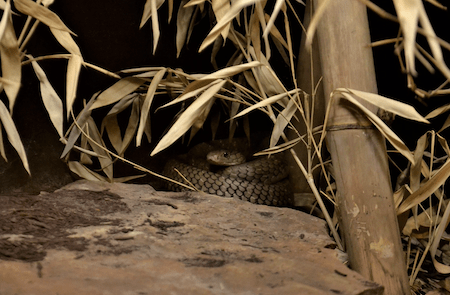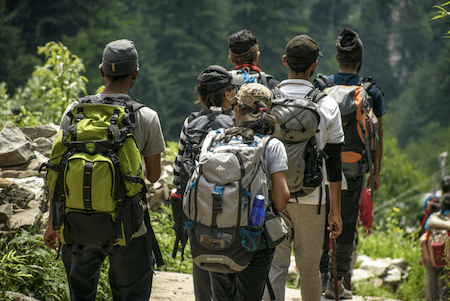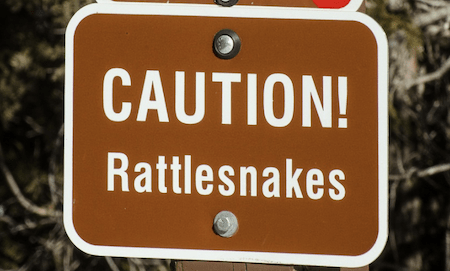Hisssss!
Does the sound of snakes scare you?
Well, no one likes to see a snake suddenly popping up out of nowhere.
Some snakes can even carry deadly venoms that can kill you right on the spot, you never know!
If you are planning to go on a hiking trip which is somehow a suitable place for snakes, then be prepared!
You might be wondering now, how to avoid snakes while hiking.
Well, for your ease, we have come up with this article that will show you practical ways to save yourself from snake bites, even if you are hiking in a snake-prone area.
Table of Contents
Tips to Avoid Snakes While Hiking
There are certain precautions and technical tips to follow if you want to have an amazing hiking experience in a snake habitat area.
Let’s discuss them one by one.
#1. Get to Know Your Hiking Area Well
Just before you head towards your hiking spot, make sure you have a well-researched idea about the place to know what kind of wildlife you may come across.
The way people check the weather condition, the water supply of their hiking area, the same way you need to also check if somehow your desired place is a great habitat for snakes.
If it’s a snake-prone area, then you must also know whether you will encounter venomous snakes or non-venomous ones while hiking.
Some hiking places might surprise you with deadly venomous snakes like rattlesnakes, water moccasins, copperheads, and coral snakes.
So, it’s better to know about probable snake threats from national or state park rangers and also from a local biologist prior to starting your hiking adventure.
You can also hire a field guide with you to specify the specific type of encountered snakes, rather than guessing it on your own.
Once you know your hiking area well, it will be easier for you to prepare against the probable dangers of snakes.
#2. Stay Away From Probable Danger
You should also have some good ideas about snake ecology which will eventually help you to become more cautious about probable places and time to encounter them.
Due to their ectotherm feature, they need to depend on outside sources to get the necessary heat for their bodies.
That’s why you will most likely encounter them in the evening or early morning stretching around trails to get the daily fuel of energy. When the weather is too hot, you will find them resting under limbs and rocks as well.
You may also discover some snakes in leaf, rocky crevices, tree canopies, and debris depending on the species of snakes.
Additionally, you need to also avoid places where tall weeds and underbrush are available, as they can also surprise you with venomous rattlesnakes.
#3. Wear Long Pants And Boots
Once you gather some knowledge about your hiking area and snake ecology, the very next thing you need to be concerned about is to take the necessary actions to prevent yourself from snake bites.
Wear long thick best hiking leggings and hiking boots which will provide you an extra protective layer against unexpected bites of snakes.
As a hiker, you should never wear sandals or go barefoot in places where you have no clear idea about the probable danger that might be waiting for you!
Snakes are more likely to reach your legs if they bite you. So, if your legs are covered with thick pants and your feet are secured with the best snake gaiters, then it will be hard for them to harm you.
#4. Do NOT Annoy or Touch a Snake
Some people have this naughty habit of annoying or killing snakes without any proper reason. Just because you encountered wildlife and it seems scary, that doesn’t necessarily mean you have to disturb or kill it.
Though snakes seem scary, remember one thing that they are more scared of you as you are smarter, bigger, and warmer.
Even if they hiss, rattle, and make S-shape, they are more likely doing all these to warn you not to harm them, rather leave the place like a good boy!
Until and unless you annoy them, they are not interested in biting you.
But yes, there are exceptional cases where some snakes can strike you all of a sudden, even if you don’t annoy them such as rattlesnakes.
Try to even avoid dead snakes, as sometimes they act like dead to make you fall into their trap. Their bites can still harm you even if the snake is freshly killed just a few minutes back!
#5. Don’t Hike Alone
If you are going to hike in a snake-prone area, then it’s a must to hike in groups.
Hiking alone in such places is pretty much life-threatening, because if you are bitten by any snake somehow, then no one will be there to help you out.
You might die without having life-saving treatment, so never ever take that risk.
Having a hiking partner walking side by side works like a big hope in terms of such danger when people get bitten by snakes.
Your hiking partner can even take a picture of the snake for further investigation to treat you well.
You know it well, “united we stand, divided we fall”!
#6. Follow Snake Safety Warning Signs
Some hiking tracks are safer until and unless you cross the path limit and go deep into the danger zone.
If you see an alarming sign of snake safety, then you shouldn’t fantasize about going out of the track and make yourself fall into danger on your own.
So, follow the warning signs and try to keep yourself on track for safe hiking.
#7. Don’t Be Panicked, Act Smart
If you somehow encounter a snake, the first rule is, don’t get panicked. It’s pretty much obvious that if you are trekking in their territory, then they will appear in front of you even if you don’t want to.
After coming across any of them, take your time and give some space to that wildlife to go away to a safer place.
If you have some prior knowledge, try to identify the specific type of that snake, which might help you in terms of unwanted accidents.
Most snake bites usually happen when people try to annoy them or kill them without any proper reason. So, as a form of self-defense, snakes attack and people die out of it.
Whether the snake is venomous or not, you better leave it alone and move away from the place safely. People who get bitten by snakes, only a few of them die because most serpents are non-venomous.
So, you don’t need to panic much, even if you happen to interact with them. Sometimes panicking gets more deadly than the real danger itself!
What to Do If You Get Bitten?
Even if you follow all the tips and tricks to avoid snakes while hiking, there are still chances you might get bitten by any of them.
So, what to do right the moment you are bitten by a snake?
Well, first of all, keep calm, though it seems hard!
Yes, you don’t need to panic, rather calm yourself and act wisely step by step.
Usually, you are more likely to encounter nonvenomous ones, so things will not get worse initially, but you need to be concerned about further infection.
Use your first aid kit box to wash out the bitten area with water, soap, or alcohol wipes. However, in terms of venomous snake bites, things will be quite different.
Don’t try to form a tourniquet, it will eventually damage the nerves of the limbs. Sucking out the venom actually doesn’t work and not even cutting the bitten area for increasing blood flow.
You should quickly go back to your car and drive to the nearest hospital as early as possible, your hiking partners can lead the whole process as well.
As a hiking partner, you need to keep in mind that the victim should be immobilized, and using a splint around the bitten area might be beneficial for him.
You need to also ensure that the victim’s bitten area is lowered compared to his chest. Putting a mild tight bandage over the bitten area can restrict the venom to flow with the blood.
As a victim yourself, either you have to get the exact antivenin you need or require medical treatment to save your life.
Though venomous bites are painful and scary, they are not as fatal as they are being thought and perceived by most of us, the percentage of death is pretty low.
To get the right treatment, it would be an advantage if you can identify the snake species, color, and other details.
Final Words
Snakes are scarily beautiful creatures that play a vital role in the whole wildlife ecosystem. Hiking in a snake-prone area can be adventurous fun but also life-threatening at the same time.
But, once you know how to avoid snakes while hiking, you can enjoy the thrilling experiences out in the wild with more safety.
We hope this article was helpful enough for you to dare to go on a hiking trip even if the location is full of hissing, rattling dangers!






